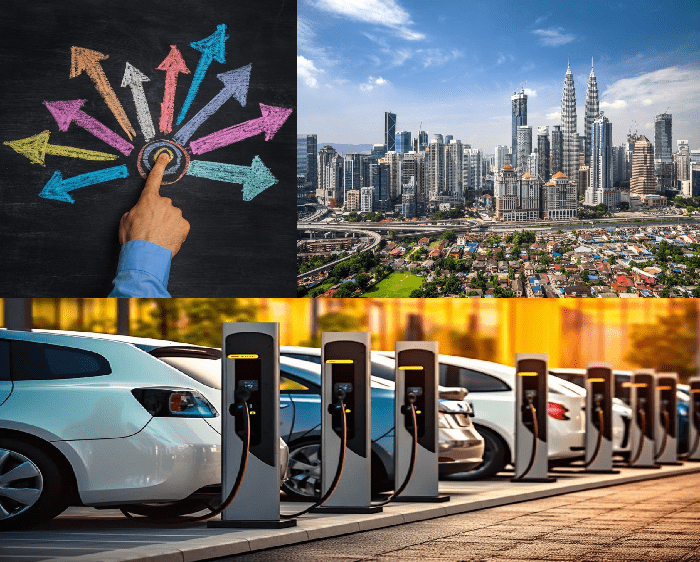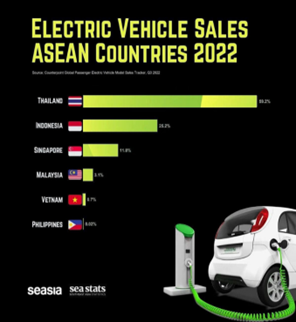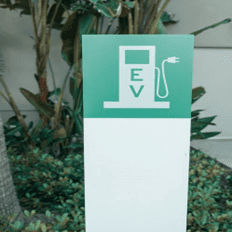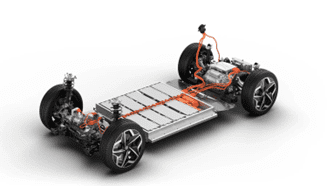Factors Affecting Consumer Adoption of Electric Vehicles: Challenges in Malaysia
- On Aug, 12, 2024
- Admin
It is reasonable to argue that battery-powered automobiles are dominating the auto industry. In spite of the macro-economic and geopolitical uncertainty, high commodity, energy prices, COVID-19 pandemic, the ensuing supply chain delays, the market for electric vehicles (EVs) has grown significantly. EV sales are still growing quickly in spite of these recent difficulties and growing production costs brought on by rising raw material prices. They are expected to outsell cars with internal combustion engines, or conventionally propelled vehicles, if this trend continues. China, the US, and the EU control the majority of the world's EV market; they also continue to drive innovation, establish trends, and influence how widely electric vehicles will be adopted in the future. Growth is hampered, though, by the requirement for EV charging infrastructure. However, there are more and more public EV charging stations, which makes them more accessible to users.

| Model | Country | EV Sold |
|---|---|---|
| Tesla Model Y | U.S. | 772,364 |
| Tesla Model 3 | U.S. | 364,403 |
| BYD Atto 3 / Yuan Plus | China | 265,688 |
| BYD Dolphin | China | 222,825 |
| GAC Aion S | China | 160,693 |
| Wuling HongGuang Mini EV | China | 153,399 |
| GAC Aion Y | China | 136,619 |
| VW ID.4 | Germany | 120,154 |
| BYD Seagull | China | 95,202 |
Source: https://www.visualcapitalist.com/electric-vehicle-sales-by-model-2023
In Malaysia, 10,159 EVs (passenger and commercial) were sold in 2023, a 386% increase from 2,631 units sold in 2022. Over time, Malaysia has seen a notable increase in the sales of electric vehicles. Just 278 units were sold in 2021. Later, in 2022, this number increased tenfold to 2,631 units, and in 2023, it nearly quadrupled to 10,159 units. 13,068 electric cars have been sold in the past three years, according to MAA's records. This segment is also expected to grow in 2024, as more models are introduced and tax breaks remain in place. With an industry volume of 799,731 units in 2023, the total sales of electric vehicles (EVs) accounted for 1.27% of all vehicle sales. Along with the increase in EV sales, the number of public chargers has increased. The number of units has increased from 1,246 to 1,434 since the last report. Malaysia aims to install 10,000 public EV chargers by 2025.

As one of the first countries to adopt EVs, Malaysia only has a 3% market share in the Southeast Asian EV market as of Q3 2022.
The industry is getting ready to reach the ambitious goal of zero emissions by 2050, with EVs playing a significant role in this effort. It is more important than ever to accelerate the transition of the energy process in order to achieve in order to net-zero emissions by the middle of the century, especially considering that cumulative emissions after 2030 must be negative in order to comply with climate goals. Government laws have played a significant role in the uptake of EVs, and numerous countries have implemented successful initiatives to promote EV ownership.
According to recent accords, Europe is spearheading the worldwide electric vehicle revolution and setting the bar for other nations. Consumers are strongly compelled to purchase electric vehicles. One important factor influencing future purchasing behavior is the consumers' intentions to make purchases. A person is more likely to follow through on a purchase if their intention to buy is stronger. However, there are factors, which influence the consumer behavior regarding making decision.

Factors Affecting Malaysian Consumers' Adoption of Electric Vehicles
Cost of Purchasing Electric Vehicles
Many consumers believe that the cost of purchasing an electric vehicle is a barrier to the adoption of these vehicles. Due to customers' reluctance to make a sizable initial investment, one of the main barriers to buying an electric vehicle is its relatively high initial cost. According to conventional thinking, EVs are more expensive to purchase and operate than ICE vehicles. The truth is more nuanced. EVs now have a disadvantage in manufacturing costs. EVs still have greater upfront costs than ICE vehicles, despite a significant decline in battery costs over the last ten years. An EV purchase for first-time owners may also involve additional expenses like setting up a home charger and even changing electricity plans.
Although EVs have greater initial expenditures, their electric drivetrain provides a unique driving experience. Because they do not have gears, EVs accelerate and torque more quickly and silently than combustion engines. Battery technology introduces limits as well as flexibility. While batteries enable owners to "refuel" at home, most EVs have a smaller range than equivalent internal combustion engines (ICEs), and battery refilling takes longer. Currently, drivers may need to modify their parking and driving habits due to range and charging limits.
Maintenance
Moreover, running expenses for EVs are typically lower. However, these savings can differ significantly between regions and over time, contingent upon the price of liquid fuel and energy that an EV customer may encounter. The Malaysian government's Imbalance Cost Pass-Through (ICPT) mechanism will no longer provide the two sent per kWh rebate to domestic consumers who use between 601 and 1,500 kWh of electricity per month. This announcement was made by the Energy Transition and Public Utilities Ministry and will apply to customers from January 1, 2024, to June 30, 2024. This indicates that starting the next year, there will be three tariff tiers for household users:
| 1 | Those who consume 600 kWh or less of power monthly will receive a two-cent ICPT rebate per kWh. | |
| 2 | Individuals who use between 601 and 1,500 kWh of power per month and who do not pay a premium but do not receive an ICPT rebate. | |
| 3 | There is a surcharge of 10 cent per kWh for customers, who use more than 1,500 kWh of power every month. |
From an automotive standpoint, the change implies that, although in a different way than homes consuming more than 1,500 kWh, households with electric cars (EVs) will pay more to charge them at home. Expect an increase unless you chance to use almost no electricity at all when charging the automobile.
Malaysian fuel costs fluctuate over time as well. In particular, gasoline and diesel (Ron 97). While Ron 95 is subsided by the government since April 2021 and the price (2.05 RM) is unchanged until today. Due to regional differences in electricity and fuel prices, variation in the operation cost savings offered by EVs and ICEs is debatable. Below the table shows the comparison between the EVs and ICEs fuel consumption.

BYD electric vehicles batteries
| Brand | Year | Battery Capacity (kwh) | Range (km) | Cost (RM) |
|---|---|---|---|---|
| BYD Atto 3 | 2023 | 60.5 | 480 | 50.88 |
| Nissan leaf | 2022 | 40 | 270 | 33.64 |
| Hyundai Ioniq 5 | 2022 | 58 | 385 | 48.77 |
| Brand | Year | Fuel Tanl Capacity | Range (km) | Cost (RM) |
|---|---|---|---|---|
| Perodua Myvi | 2023 | 36 | 756 | 73.8 |
| Toyota Vios | 2023 | 40 | 760 | 82 |
| Proton X50 | 2023 | 45 | 702 | 92.25 |
Maintenance Cost Difference
Internal combustion engines (ICEs) have more moving parts than electric vehicle (EV) motors, and the prevalent notion is that EVs require less maintenance. Insurance, tire replacement, and other routine maintenance expenses are necessary for both EVs and ICEs, but the electric powertrain does away with the necessity for some engine maintenance, such as oil changes and replacement of components of the ignition system (spark plugs, for example). Available studies indicate that the continuing maintenance expenses of a car with a fully electric powertrain are around 60% less than a vehicle with a partially or totally fuel-powered drivetrain. However, the actual savings on maintenance costs are typically minimal. It is challenging to estimate maintenance expenses for earlier EVs due to the short history of EV ownership, especially those related to battery replacement and deterioration. It is anticipated that battery costs would decrease further, but future battery replacements might still be expensive.
Availability of Charging Stations
The major problems for EV users in Malaysia,
• Is the absence of charging outlets along the route. Most countries have a concentration of charging stations in a certain neighborhood, which poses a problem for consumers in terms of where and when to get service. For instance, according to the Malaysian Automotive Association (MAA), the increasing number of EV sales, the number of public chargers has also increased. Last reported at 1,246 units, the number has now risen to 1,434 units. The target for Malaysia is to achieve 10,000 public EV chargers by 2025. In Malaysia, most of public EV chargers are found in the country's major western cities, including Kuala Lumpur, Selangor, Pulau Pinang, and Johor.
• The EV market has four chargers that are widely available: Level 1, Level 2, Level 3, and Level 4 chargers.
| Level 1 and Level 2 chargers use alternating current (AC). Direct current (DC) can be obtained from the local power system and transformed into DC by an onboard inverter in an all-electric vehicle. |
| Chargers categorized as Level 3 and Level 4 are powered by DC and are typically installed exclusively in commercial spaces. |
• Malaysia only offers 3 DC charger units worldwide and just 3.7 kW, 7 kW, 11 kW, and 22.0 kW AC chargers, according to ChargeNow, BMW's global e-Mobility service monitor. (Alghoul, M., Hammadi, F., Amin, N., Asim, N. (2018). The role of existing infrastructure of fuel stations in deploying solar charging systems, electric vehicles and solar energy: A preliminary analysis. Technol. Forecast. Soc. Chang. 137, 317–326) Malaysia, therefore, needs a more advanced infrastructure for rapid charging that has a larger capacity.
• Another major financial hurdle is setting up a public charging infrastructure with fast chargers.
• The small number of charger standards that are currently accessible presents another difficulty when developing policies for the infrastructure necessary for charging. Various standards for EV charging have been considered by different parts of the world. As a result, it is crucial to comprehend the standards and create regulations that are consistent with them. It will be very difficult to use several standards, especially when charging an electric car at home because the owner has to know which charger is right for the vehicle they bought.
How Much Time Does an Electric Car Take to Charge?
• The level of the chargers (Level 1 to Level 4) affects how long the charging takes as well.
• Level 1 requires no additional circuitry and is equivalent to the built-in charger found in most EVs that plug into domestic power outlets. It is discovered that it will take over 17 hours to fully charge a 24 kWh 40 kWh battery when utilizing a Level 1 1.4 kW household outlet.
• Three-phase Level 2 chargers can fully charge an electric vehicle in seven to nine hours. For instance, it takes seven hours for a 40 kWh battery to be fully charged using a Level 2 charger (6.6 kW).
• The EV battery is immediately charged by Level 3 and Level 4 chargers using sophisticated DC charging methods. In 15 to 20 minutes, these superchargers can charge the battery to 80% capacity.
• It is not recommended to use superchargers for more than twice a day in order to maintain longer battery life. Therefore, unless an EV user has access to Level 3 or Level 4 chargers or lives close to a supercharger, charging an EV battery with a standard charger will take a lot longer.
• Moreover, an EV with a 70–100 kWh battery is no longer desirable or practical for charging.
• Additionally, if the user needs to wait in line to refuel their EV at a public charging station, a lot of time will be lost because the charging period is very long and there is not a lot of infrastructure available for charging. Therefore, the psychology of EV buyers and the public’s decision to switch to EVs are significantly influenced by the charging time of an EV.
Prospective Methods of Treatment and Upcoming Studies
Certain areas must be improved in order for EVs to be fully adopted by the transportation sector and well-received by consumers. Present literary techniques address a few of the main issues mentioned in the preceding section. This could stimulate public interest in purchasing more EVs for themselves and aid in the better circulation of EVs in the Malaysian local market.
| Current EV Target, and Policy (Economic Efficiency) | Demand for Travel (Battery Capacity) |
| Present-Day Market Value | Infrastructure for Charging |
| Requires Charging Time | User Behavior |
| Safety risks (Congestion and Accidents) | Energy Security |
| Current Policies | Supply chain (raw materials, parts etc.) |
Conclusion
As a more environmentally friendly form of transportation, electric vehicles (EVs) have attracted a lot of attention. This study found that Malaysia is still far way from adopting electric car technology to its full potential. Because an electric vehicle is expensive to buy, only a very small percentage of consumers give them any thought. The main obstacles to establishing a widespread EV culture in Malaysia include the following:
• A dearth of charging infrastructure,
• A lack of local EV manufacturers and policies,
• A lack of efficient vehicle design,
• A lack of government incentives for EV users,
• An incompatible electricity supply structure,
• A limited range for EVs,
• A lack of EV service stations,
• Moreover, excessive taxes on imported EVs.
One of the main barriers to electric automobiles is battery technology. An EV's overall cost is largely determined by the cost of its battery packs. Even though battery prices have been steadily falling, more drops are required before EVs are affordable for the typical customer. Research and development must go on in order to improve energy density and progress battery technologies.
In short, to get beyond these challenges, automakers, battery producers, and legislators must work together. Maintaining advancements in battery technology, refining motor technologies, and investigating substitute materials will all contribute to EVs becoming more accessible and desirable to a larger range of consumers. We can accelerate the shift to a more environmentally friendly and sustainable transportation system by removing these barriers.
Suggestions
The government could reduce the cost of electric vehicles by offering additional subsidies and incentives to buyers, as well as by enacting tax reductions for owners of these vehicles.
The government, road and transport ministry and authorities (JPJ) and automakers (MIROS) ought to launch a comprehensive awareness campaign emphasizing the environmental benefits of adopting electric vehicles. Road and transport ministry should lower the road taxes for electric vehicles because they emit no greenhouse gases.
Below are the guidelines for "Foreign National Students and Workers willing to get Malaysian driving licence":
“What Foreign Students in Malaysia Should Know about Driving Licence and its Conversion?"
If you are eager to know "Various Models of EVs available in Malaysia", please read the following article:
“Electric Vehicles in Malaysia: An Overview of Different Brands and Models"
About the Author
Dr. Hafiz Abbas holds a PhD in Usuluddin from Universiti Sultan Azlan Shah (USAS), Malaysia. He is well versed with Islamic theology, Seerat-un-Nabi (SAW), and principles of Hadith. In addition, he is a teacher of Arabic.
Edited by: Ch. Mahmood Anwar (PhD)
Do comment if you find this article helpful in shaping a hassle-free driving experience in Malaysia.




















